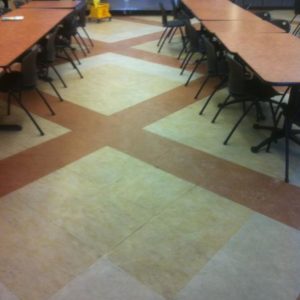My question is mostly a scenario: I have a friend who is the facilities manager at a large bio-medical company that is looking to redo their cafeteria floor. The majority of the facility is granite tile, but for some reason, they installed what looks like mastic glued 2′ x 2′ linoleum squares in the dining area. Due to the constant mopping of this floor, these tiles are starting to come loose on the edges. It appears that they’ve started to TAPE these down on the seems. I am in dire need of work for my company. This is a GIANT floor, the largest I’ve ever contemplated doing: 2556 sq. feet. Here are the issues with the project:
1. Getting the old tiles up: is there a machine that will scrape up the tiles? I removed residential sticky tiles from a basement floor we were converting into bathroom space, and it took ALL DAY scraping to get just a 10′ x 8′ section up….can’t imagine doing several thousand feet without a special machine….do they make a commerical scraping maching?
2. How to get the old mastic off the concrete after tile is removed? I’ve noticed there is a non toxic solvent called Citrus KIng that appears to remove a wide range of glue….will this work?
3. Another issue: the walkway that borders the cafeteria floor is divided by a metal strip, BUT it appears that the concrete that is covered by the “sticky tile” isn’t as deep as the granite tile side; this would prevent installing tile unless the concrete is grinded down to give space for the thickness of the tile.
4. My friend told me they’ve budgeted $25,000 to $30,000 for the job, but GRANITE tile to match is at least $5-$10/sq. ft. just for the tile.
SO, I was thinking to install a self-leveling concrete overlay system. Does that seem like the smartest material to install?
I need this job desperately, and I’m hoping that it will lead to more commercial work, but my experience isn’t in commercial work, but residential. I have the inside track to get the job, but I don’t want to let my friend down, or lose money. The unknowns for me are:
Getting the old tile up, limitations on the concrete product, and how efficiently the new surface can be installed. Any thoughts on this project are greatly appreciated…..
I am sincerely desperate for this work but am afraid of the unknowns….






















Replies
There are several variations on the concept of a power floor scraper.
Before you start (or even bid the contract) you should be sure that there's no asbestos in the tile or mastic. Get it tested, even if you must pay for the tests yourself.
No asbestos....building is only five years old
I don't know why they didn't just run the granite tile throughout....what a waste. The mastic is that horrible yellow stuff. I've looked into the citrus removers and the soy products. It's a HUGE floor( 2535 sq. ft!), any idea if soy or citrus remover would be better?
Stop
With questions like this, in a place as professional as a bio lab, you should disqualify yourself. You are in way over your head
It's a friggin' cafeteria.
It's a friggin' cafeteria.
But he has admitted that he has no idea how to prep the floor, and that it is by far the largest floor he has ever done. The owner has $25K budgeted, but if the OP screws up, he could be in the hole for another $10
Yeah, the reason to be leery is simply that it's a bigger project than he's done before, using technologies he's unfamiliar with. Could be in a horse barn and it would be the same issue.
I would guess an appropriate replacement would be VCT. You could retain the original architectural details, but correctlt installed is much more resistant to mopping and wear than linoleum is.
The key to any sheet or VCT is prep, getting the glue off anf the surface coated with a dead flat cementeous product. If you don't know how to do this, the middle of a cafateria is not the place to learn.
Call a commercial floor covering outfit
You should learn to Google
Did a quick Google search just to see what I found:
I already knew this but I did a Google search for "commercial floor scraper", just to see what you would get. It turned up a plethora of commercial floor scrapers. Ranging from small pnuematic ones to propane or battery powered ones the size of small fork lifts. And, more accessories than I knew were out there, including an attachement for a skid steer loader, with a 36-inch cutter.
Generally you don't use solvents. A good scraper works best without any thing to make things softer and gooy.
So far as the concrete under the tile being higher, that is probably common. If they really want stone floors, I would rccomend grinding only the perimeter for enough rows of the new tile to provide a transition, and making this transition a contrasting color to give people a visual clue something is different.
The first thing to figure out is why the existign is failing. My guess is that it was put down with one of the early water based adhesives, and that the soaps in the mop water are allowing the adhesive to rehydrate.
A better solution than ripping up the floor might be to install a good commercial grade sheet floor over the top with welded seams, so that it is essentially one large floating floor. Done by a skilled worker, the seams are invisible.
Finding a sub would probably be a problem
A better solution than ripping up the floor might be to install a good commercial grade sheet floor over the top with welded seams, so that it is essentially one large floating floor. Done by a skilled worker, the seams are invisible
My entire construction career has been commercial and industrial. I don't think that you could find a reputable and skilled flooring contractor/sub who would lay sheet or any other type of flooring over a existing floor that is already failing. Most flooring contractors want to lay down on top of concrete or a sound underlayment grade ply.
I wouldn't trust a sub who would apply on a peeling, poorly installed linoleum